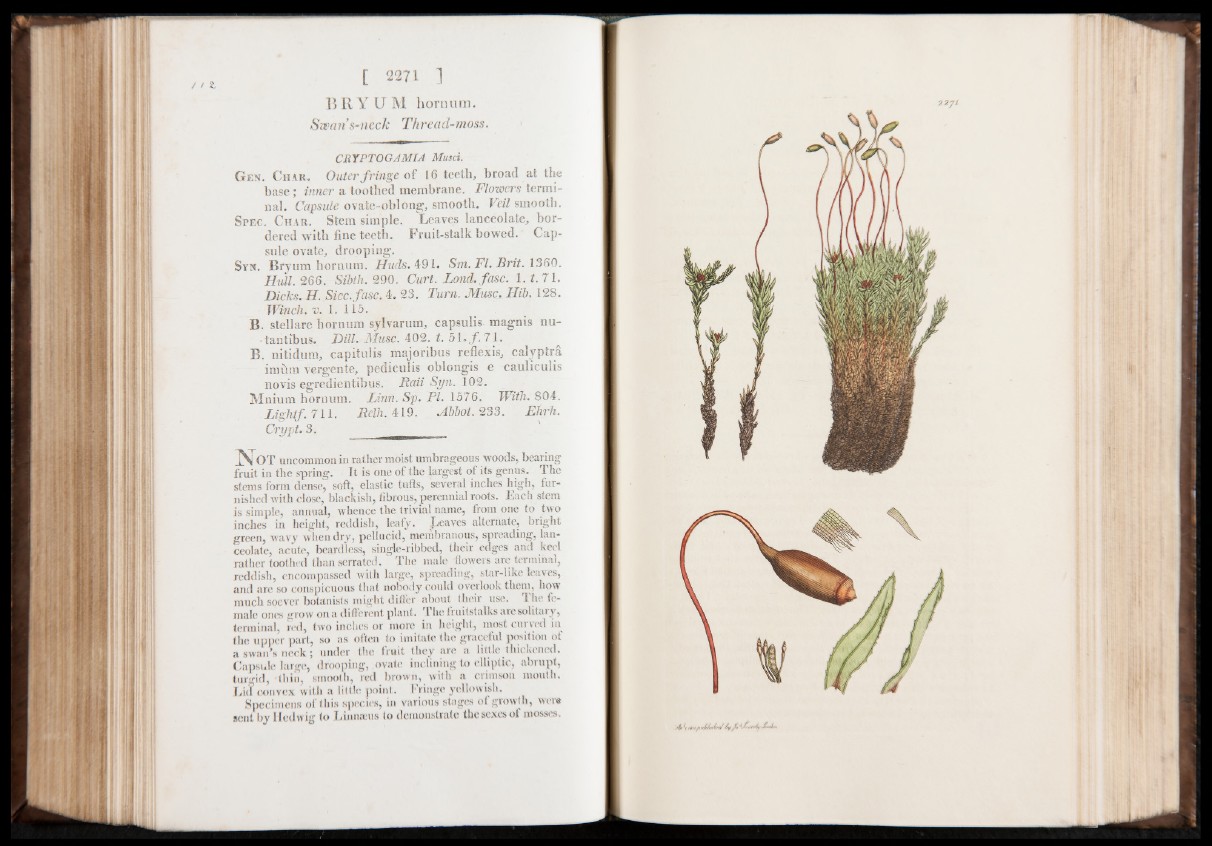
/ / a Lr 227' 1 1J
B R Y U M hornum.
Swnns-neck Thread-moss.
CRYPTOGAMIA Musci.
G en. C h a r . Outer f r in g e of 16 teeth, broad at the
base; inner a toothed membrane. Flowers terminal.
Capsule ovate-oblong, smooth. Veil smooth.
S p e c . C h a r . Stem simple. Leaves lanceolate, bordered
with fine teeth. Fruit-stalk bowed. Capsule
ovate, drooping.
Syn. Bryum hornum. Huds. 4 9 1. Sm. FI. B r it. 1360.
Hu ll. 266. Sibth. 290. Curt. L o n d .fa s c . 1 .1 .71.
D ick s . H . S ic c .fa sc . 4. 23. Turn. M u se . Hib. 128.
Winch, v. 1. 115.
B. stellare hornum sylvarum, capsulis magnis nu-
•tantibus. D ill. Muse. 402. t. 5 1 . f . 71. ^
B. nitidum, capitulis majoribus reflexis, calyptra
inium vergente, pediculis oblongis e cauliculis
novis egredientibus. R a ii Syn. 102.
Mnium hornum. Linn. Sp. PI. 1576. With. 804.
L is h tf . 711. Relh. 419. Abbot. 233. Eh rh.
Cryp t. 3 . |
ISTOT uncommon in rather moist umbrageous woods, bearing
fruit in the spring. It is one of the largest of its genus. The
stems form dense, soft, elastic tufts, several inches high, furnished
with close, blackish, fibrous, perennial roots. Each stem
is simple, annual, whence the trivial name, from one to two
inches in height, reddish, leafy. Leaves alternate, bright
green, wavy when dry, pellucid, membranous, spreading, lanceolate,
acute, beardless, single-ribbed, their edges arid keel
rather toothed than serrated. The male fioweis are terminal,
reddish, encompassed with large, spreading, star-like leaves,
and are so conspicuous that nobody could overlook them, how
much soever botanists might differ about their use. The female
ones grow on a different plant. The fruitstalks are solitary,
terminal, red, two inches or more in height, most curved in
the upper part, so as often to imitate the graceful position of
a swan’s neck; under the fruit they are a little thickened.
Capsule large, drooping, ovate inclining to elliptic, abrupt,
turgid, •thin, smooth, red brown, with a crimson month.
Lid convex with a little point. Fringe yellowish.
Specimens of this species, in various stages of growth, were
sent by Iledwig to Limucus to demonstrate the sexes of mosses.